Ligue 1 has for a while been billed ‘The League of Talents’ — an apt title considering the number of exciting young players who have honed their craft in France’s top-flight just before skyrocketing to global superstardom in recent times, such as current Napoli star Victor Osimhen, who joined the Serie A side from Lille in 2020, or Arsenal’s William Saliba, who signed for the Gunners from Saint-Étienne in 2019.
However, at present, you can catch immense footballing talent on the sidelines as well as on the pitch; Ligue 1’s current coaching quality is some of the most compelling in all of world football, with well-known, seasoned coaches like new PSG boss Luis Enrique, new Marseille manager Marcelino and Lille’s Paulo Fonseca on display as well as tacticians with less experience but equally absorbing ideas and stories, such as Reims’ 30-year-old manager Will Still.
This article will focus more on the latter as we shine a light on three young coaches you should keep an eye on in France’s top-flight this term. All three are fresh to Ligue 1 this season in that they weren’t managing in this league last term, and the oldest of the trio is currently just 41 years of age.
All enter the campaign with absorbing backstories, as do many of Ligue 1’s coaches this year, but not everyone will end up successful. Nevertheless, it’s reasonable for fans of the relevant clubs to have belief in these coaches this season — and we’ll try and explain why with our tactical analysis and manager-focused scout report.
Francesco Farioli, 34 years old, Nice
Nice have undergone a big shakeup in the last 12 months, first bringing in former Lens sporting director Florent Ghisolfi in order to try and sort out their questionable recruitment of recent years, then appointing Francesco Farioli as manager this summer.
If you’re unfamiliar with Farioli, he’s a former member of Roberto De Zerbi’s backroom staff, having initially caught the current Brighton and Hove Albion boss’ eye after writing an article on his Foggia side.
Obviously impressed by the young Farioli’s analysis, De Zerbi maintained contact with the Firenze-born coach until asking him to join his team at Benevento in 2017 as a goalkeeping coach. Farioli would go on to be part of De Zerbi’s coaching staff at Sassuolo during an excellent run for Neroverdi that produced some scintillating football at times before the two parted ways.
Farioli joined Çağdaş Atan at Alanyaspor, becoming an assistant manager in the Turkish Süper Lig for most of the 2020/21 campaign before an opportunity to take charge of Alanyaspor’s league rivals Fatih Karagümrük, where he’d spend almost the remainder of the year before returning to Alanyaspor, this time as the boss, in December 2021. He’d go on to depart the Turkish club in February of this year.
So, it’s been a hell of a journey and an education for the 34-year-old Italian over the last six or seven years that’s led him to his current position as Ligue 1’s second-youngest manager for the 2023/24 campaign (only the aforementioned Still is younger).
Farioli is very open about discussing his ideas; in an interview with Area Coach in 2021, during his time as Karagümrük boss, the young coach was asked, among a range of topics, about his time with De Zerbi.
One interesting point the Brighton boss’ former goalkeeping coach made was regarding his view on using the goalkeeper in possession: “I’ve always thought I should do the useful things and not the risky ones, and for me, using the goalkeeper during the construction phase has always been more useful than risky.”
Even just this quote gives us much insight into how Farioli views the game and how he’ll ideally see his teams playing. Of course, as the manager also referenced, the strategy and tactics you employ on the pitch must also be suitable for the players one has available to them. But during his time with Alanyaspor last season, the Italian coach made it a critical point to sign up a goalkeeper who was comfortable with the ball at his feet, as they brought Arsenal’s Rúnar Alex Rúnarsson in on loan.
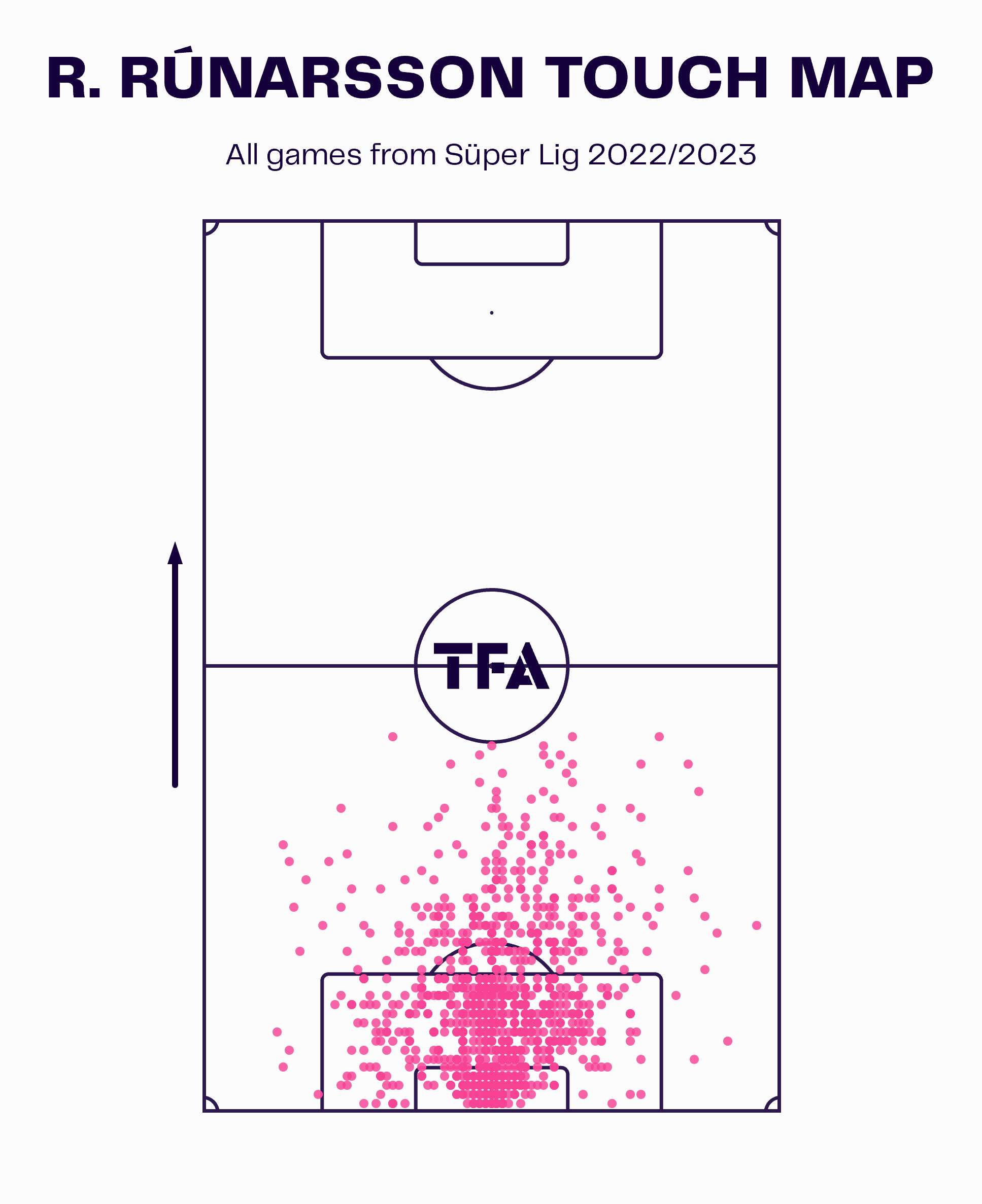
The Icelandic ‘keeper got involved in play quite high up the pitch at times, advancing into and making himself a viable passing option in far higher positions than your average goalkeeper does with the ball. This is something we can also fully expect Farioli to push with Nice this season as well.
At Alanyaspor, Farioli’s side liked to drop a lot of players close to the ‘keeper during the build-up, putting a lot of bodies very close together in a tight space, which was designed to create an opportunity for the team to put together some intricate passing plays and draw the opposition in with the carrot of them having a small area to press, along with a chance of regaining possession in a precious position.
Here, the team relies on Farioli’s training to ensure they’re prepared to deal with the situation appropriately, link up well and play their way out of trouble. In contrast, the coach relies on his players’ technical quality and decision-making (influenced by their work on the training ground) to ensure the plan runs smoothly.
We’ve already seen glimpses of Nice dropping plenty of players deep to draw the opposition high under Farioli too, so this may be a path Les Aiglons also go down this term.
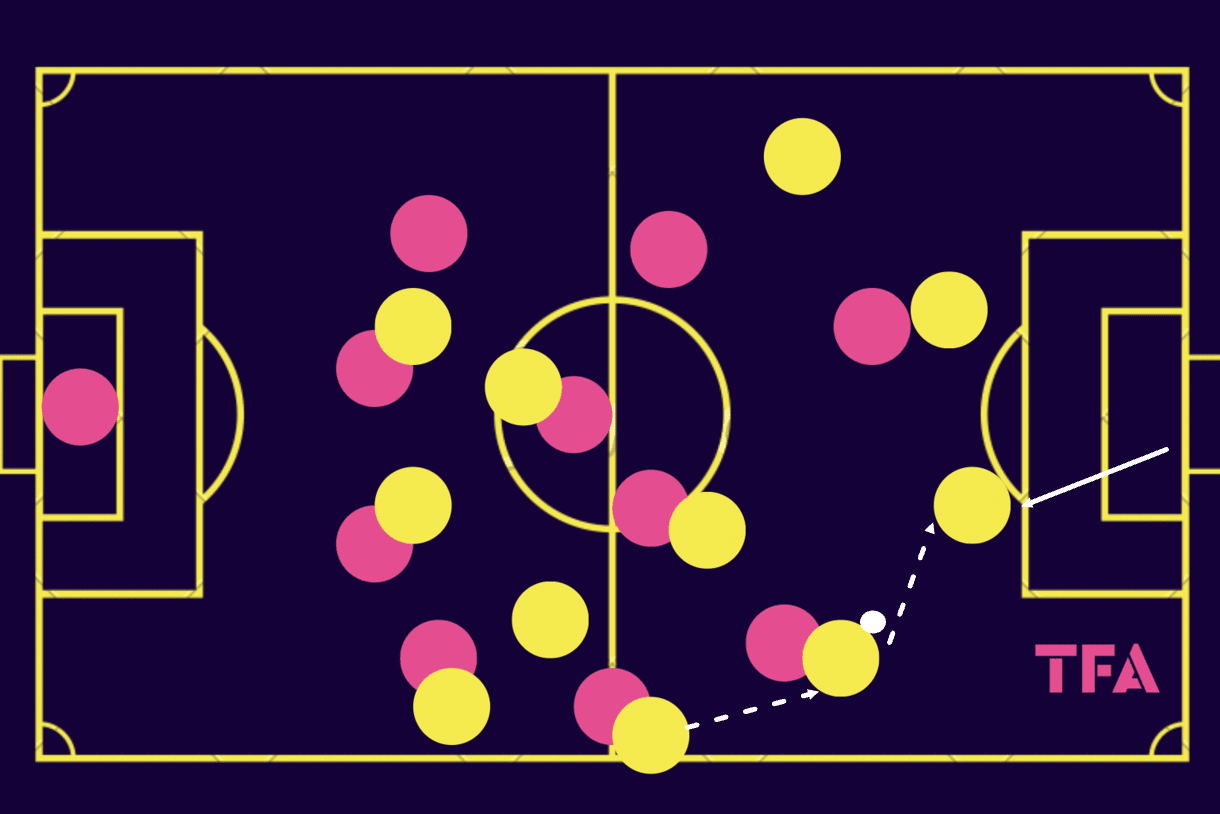
We see an example of one benefit that’s been displayed by Farioli’s teams thanks to the heavy involvement of the goalkeeper not just in the build-up but also in the ball progression phase here in figure 2.
The Italian’s ‘keeper has the license to push up out of his box and look for the ball, as is the case in this example which is actually taken from Nice’s pre-season clash with Fiorentina.
The left-back had possession out wide but was pressed into playing the ball back to the left centre-back, who’s moved out wide to support the under-pressure full-back. He can do this with more freedom and comfort knowing Kasper Schmeichel is advancing into the vacated left centre-back position, creating a +1 for Nice in the backline and easing the pressure from the opposition as he buys his team time to assess the situation and decide on their next move.
This allows Nice a central man advantage in build-up and ball progression without having to drop a midfielder, shift a full-back across or play an extra centre-back, leading to a numerical advantage for the team throughout the active playing zone. Fundamentally, there is plenty of logic in this approach, though, of course, there’s risk involved, especially if the ‘keeper isn’t extremely comfortable with the ball at their feet.
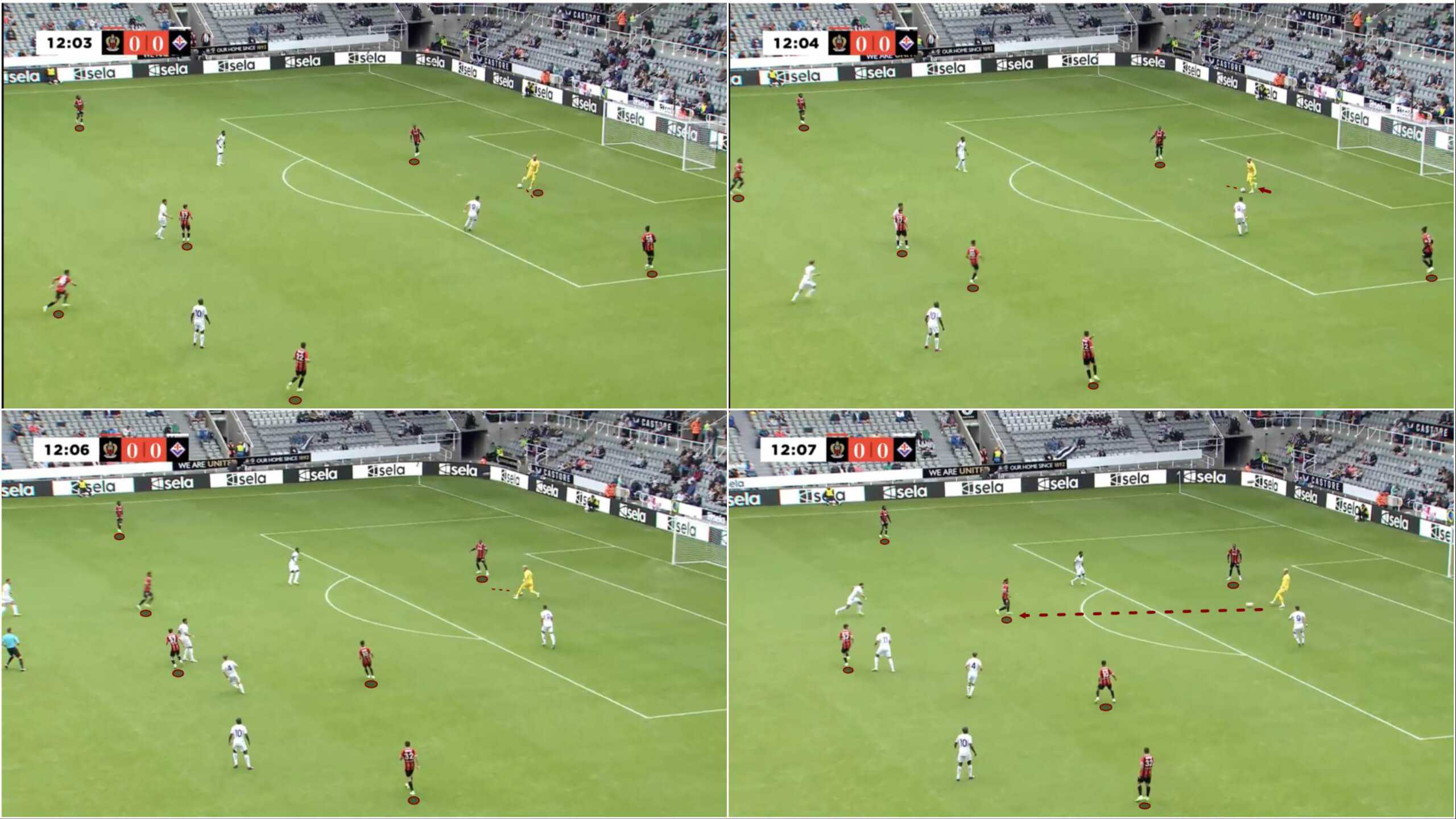
Part of the ‘keeper’s job in this situation is to wait. Just wait and draw pressure from the opposition until an excellent passing option opens up. Again, this involves plenty of risk but can benefit the team seeking to break through the opposition’s defensive shape.
For us, this is one of the more attractive aspects of Farioli’s team to keep an eye on as he takes on the highest level of competition he’s had the opportunity to manage in so far.
Luka Elsner, 41 years old, Le Havre
Moving from the youngest to the oldest of our three coaches, next up is Luka Elsner of Le Havre. This time, we don’t have someone who’s new to his team, as Elsner guided France’s oldest surviving football club to promotion from the second-tier last season. Furthermore, Elsner is not a Ligue 1 novice, having managed Amiens in France’s top-flight back in 2019/20 before moving to the Belgian Pro League for a couple of seasons ahead of relocating to Normandy.
Still, he is a young coach who didn’t manage in Ligue 1 last season, and any opportunity we get to wax lyrical about his abilities is a great one!
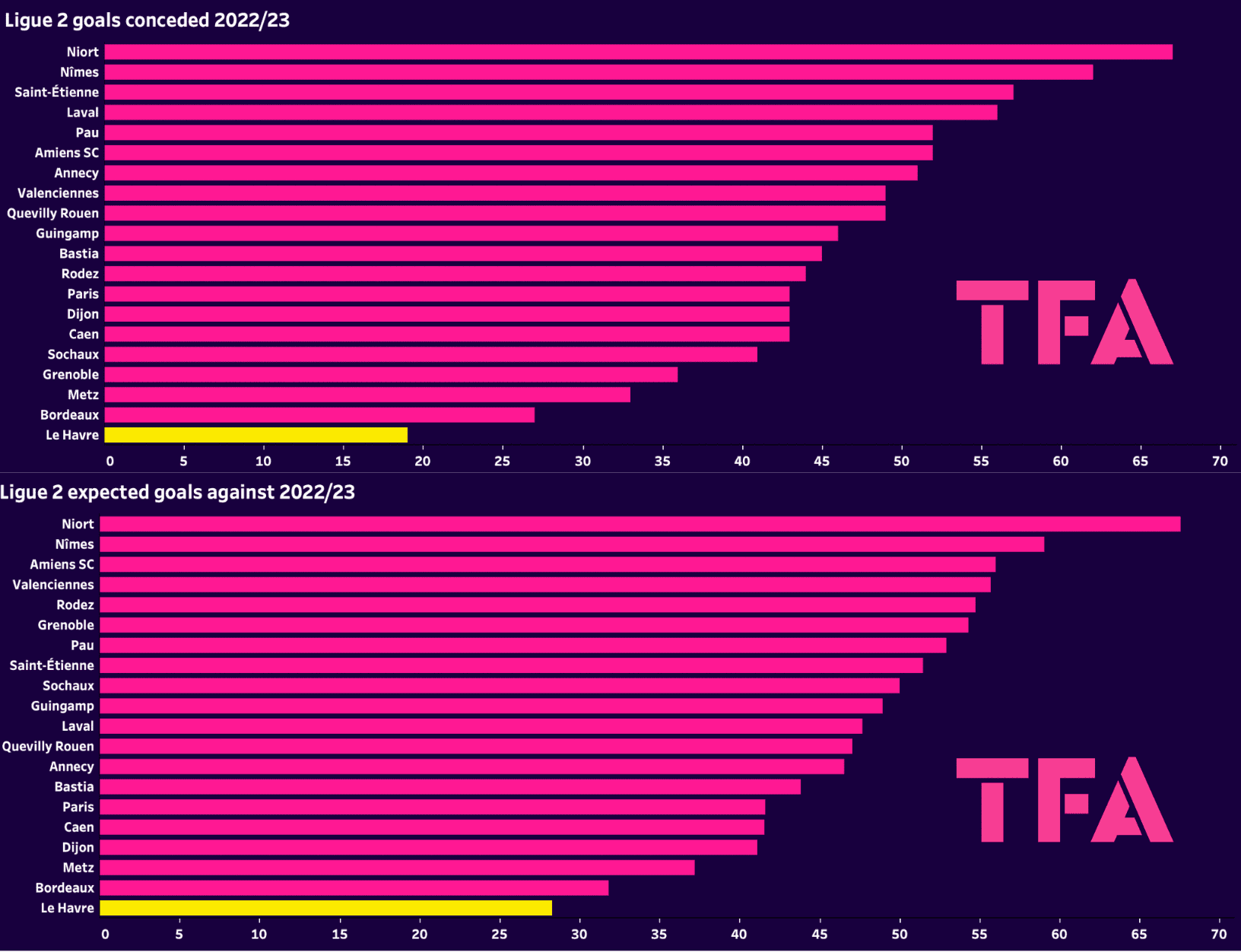
Last season, Elsner’s side really stood out in terms of their defensive solidity; this was the primary reason for their promotion from Ligue 2. They finished the season with the lowest xGA (28.31) and the fewest goals conceded (19) in the league.
Can they maintain a decent defensive record in the top-flight this season and ensure safety from the drop? Of course, their record won’t be anywhere near what it was last season, but they will need reliable out-of-possession tactics and organisation in Ligue 1, so they’re coming into the 2023/24 campaign with a decent base of having played a season under Elsner and his successful defensive approach, which can supply confidence in the boss and themselves to the players.
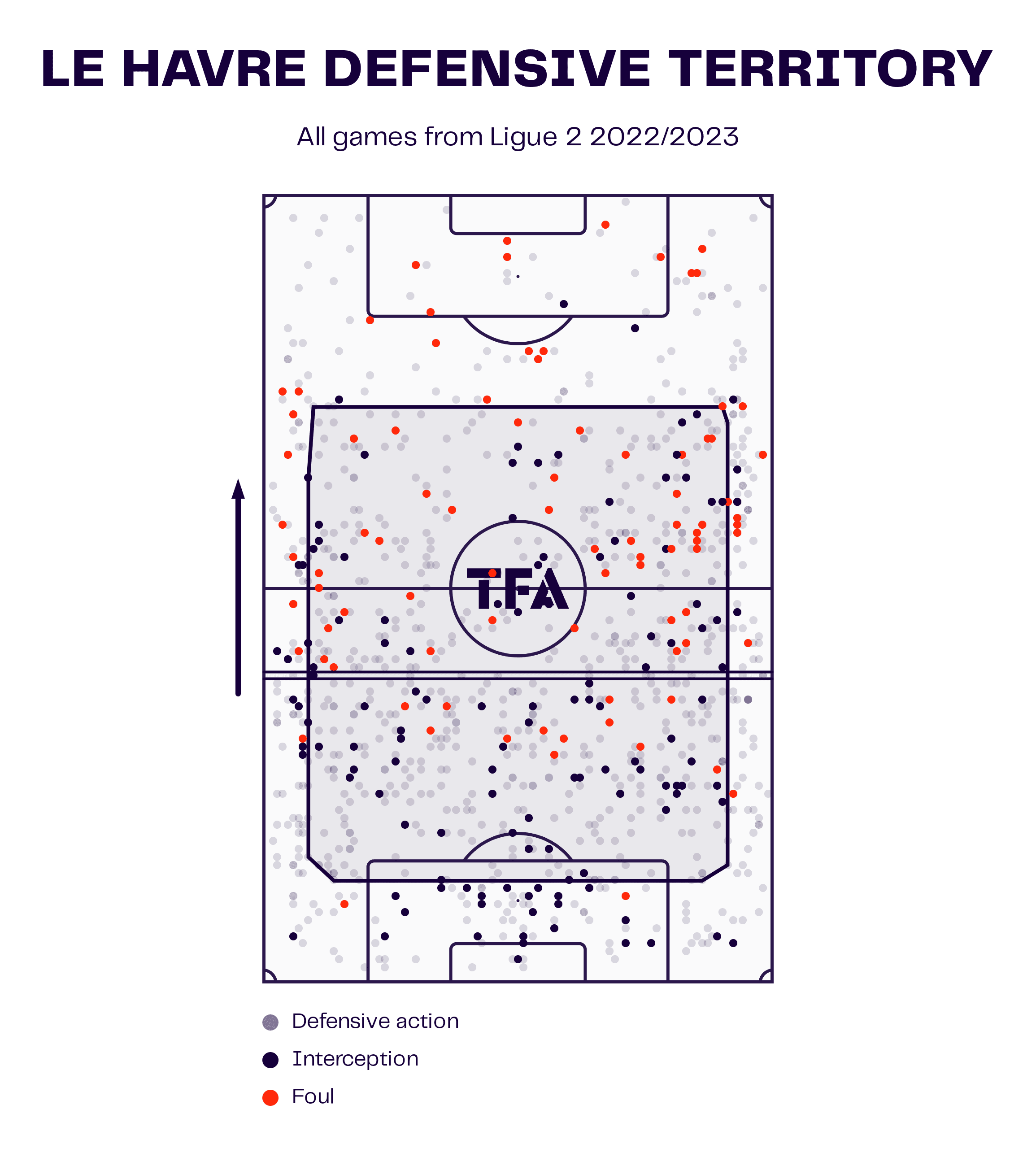
Le Havre’s average defensive line height was quite high last season, almost reaching the centre circle. They made plenty of defensive actions all over the pitch — not just inside their own half.
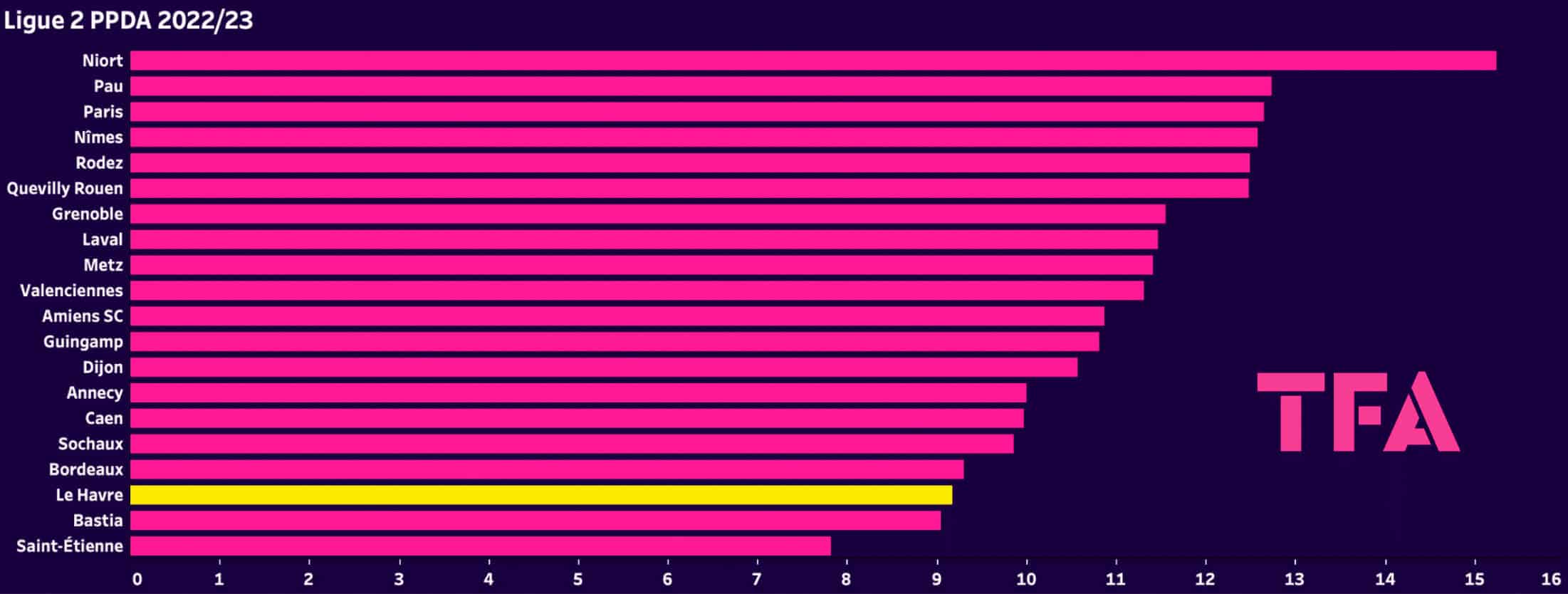
They ended the campaign with the third-lowest PPDA (9.17) of any Ligue 2 side, indicating their desire to press high and win the ball in a dangerous position from which they could very quickly create significant problems for the opposition’s goalkeeper.
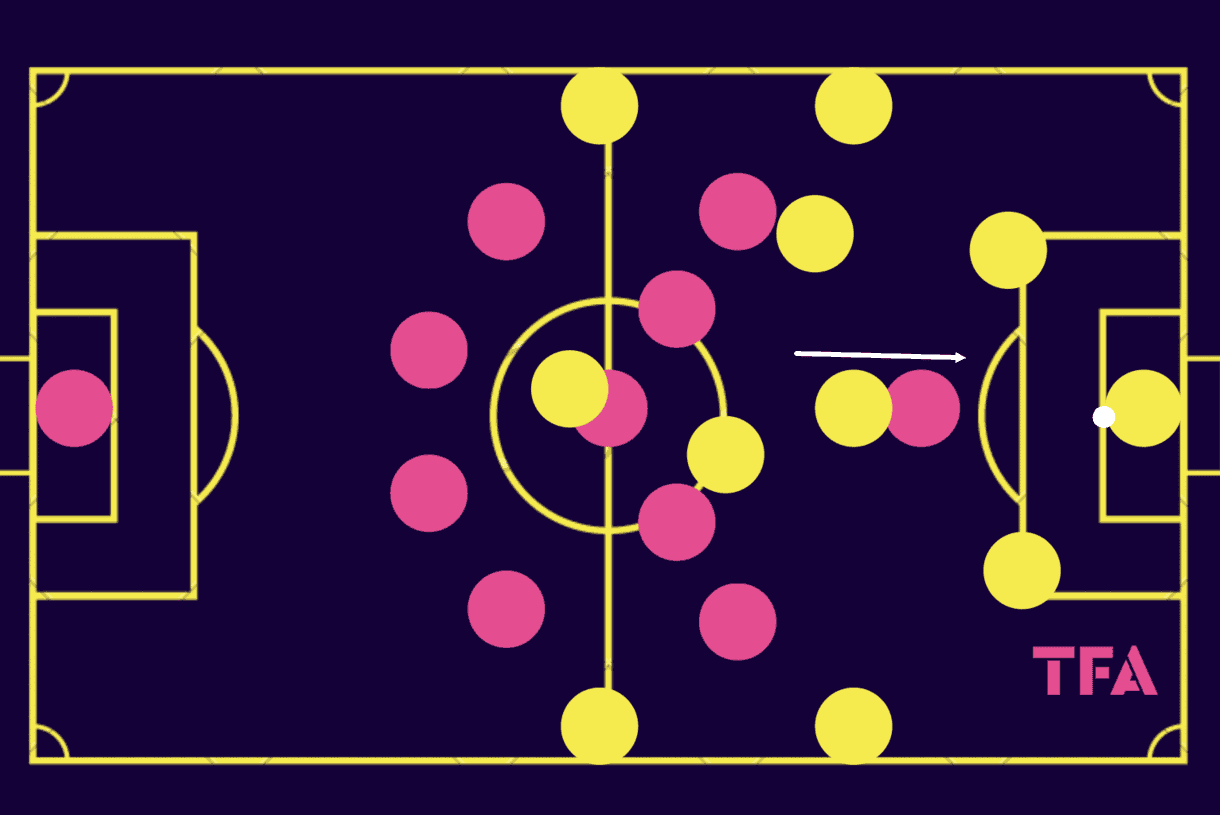
Elsner’s side primarily set up in a 4-3-3/4-1-4-1 shape with the ball last season; this changed into more of a 4-5-1 out of possession, with Le Havre deploying a fairly aggressive mid-block. The centre-forward would typically press very high, as the midfield and defensive lines focused mainly on keeping a compact structure in place and denying the opponent space in midfield to play through them.
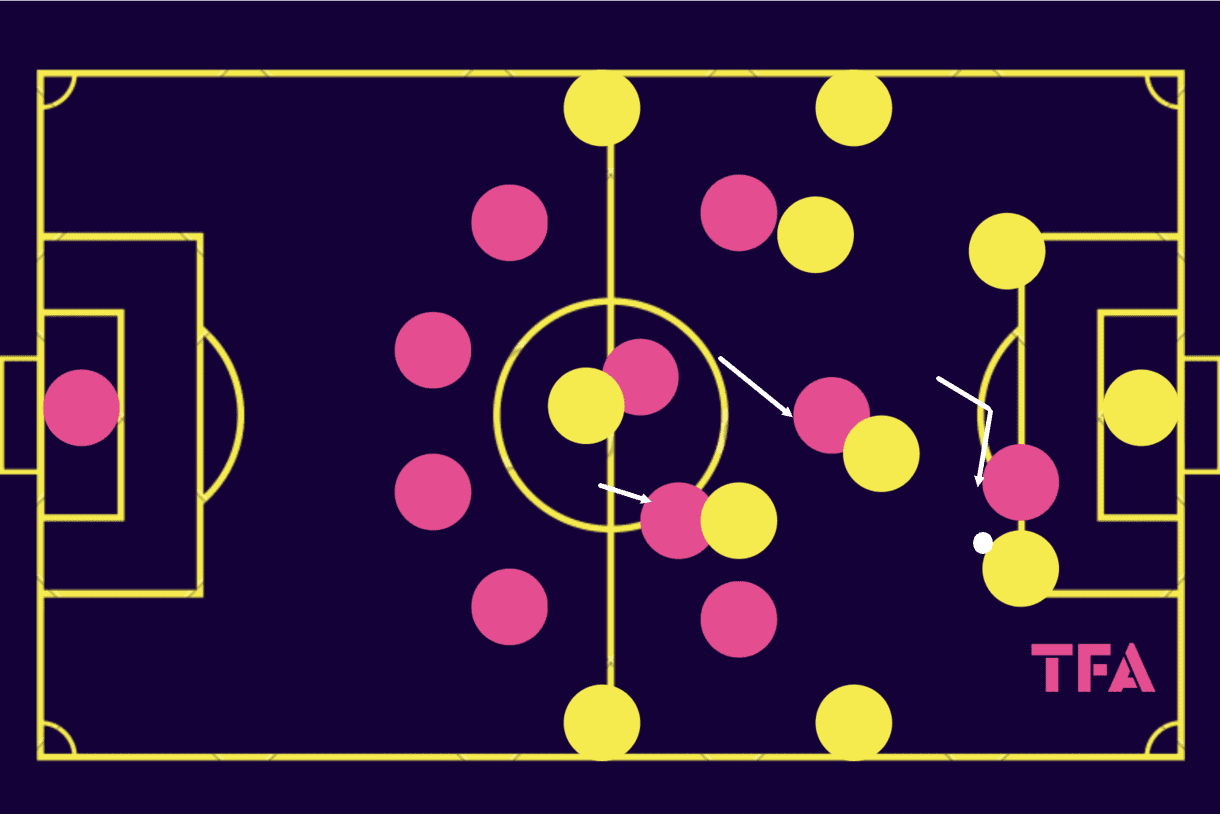
At times, this would lead to the central midfield opening up for the ‘keeper and centre-backs to play into as space would open behind the centre-forward. However, Le Havre’s main concern was ensuring the more advanced spaces between the midfield and defence remained secure.
As figure 8 displays, one way Le Havre tried to solve this problem was by advancing the ball-far central midfielder to cover the opposition midfielder dropping deep. In contrast, the ball-near midfielder remained tight to their direct opponent (assuming that the direct opponent wasn’t also the deepest midfielder).
There are still pathways into midfield here, but if either of the two midfield passing options received here, Le Havre’s nearest players would be able to close in on them, which is a frequent pressing trap that Elsner’s side utilised last season to regain the ball in central areas.
Furthermore, if the ball was played out wide, the winger could press aggressively with the comfort of the sideline being there to limit the opposition full-back’s space.
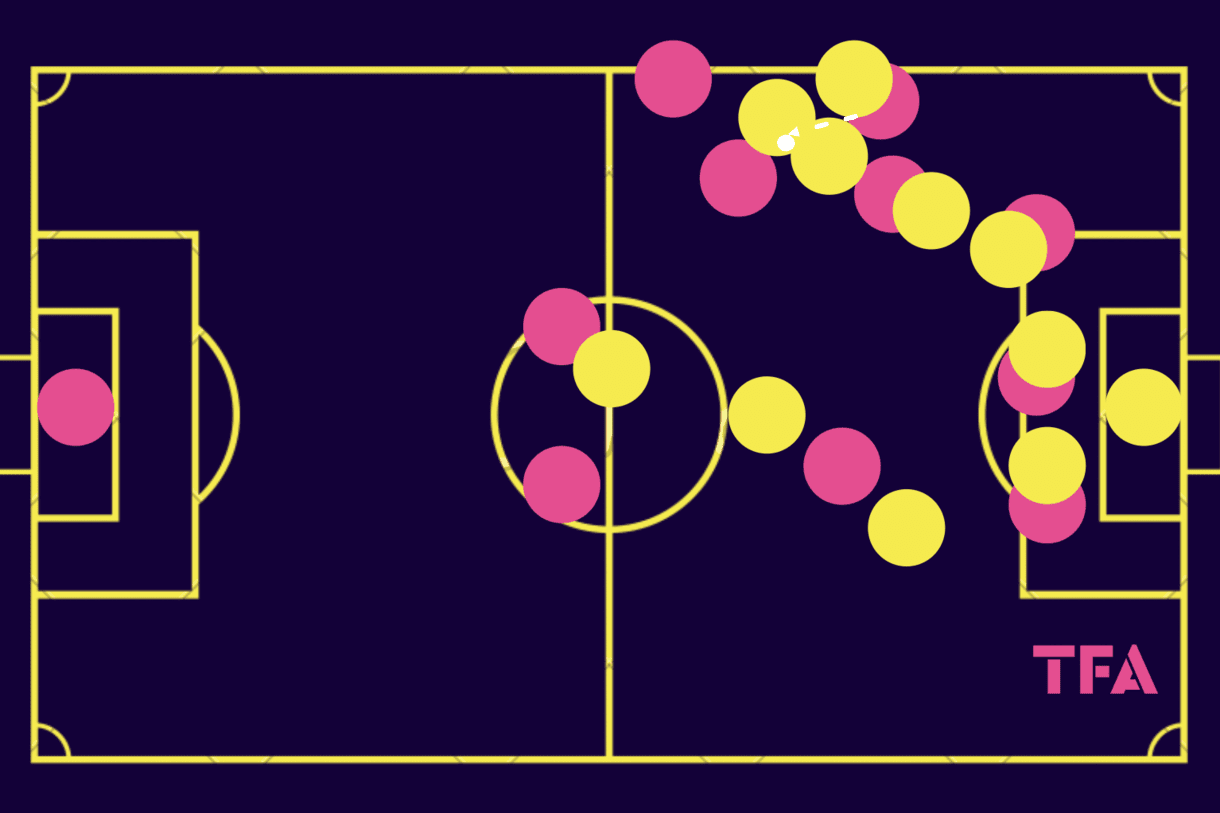
Counterpressing was another critical factor in Elsner’s tactics last season. Le Havre performed very well in the transition to defence, limiting the number of chances the opponent could create on the counter.
Here, in this case from a clash with Saint-Étienne, as the Le Havre (pink) left-winger tried to find the holding midfielder with a back pass, the ball was intercepted by an opponent who cut the passing lane very well and kickstarted a counterattack.
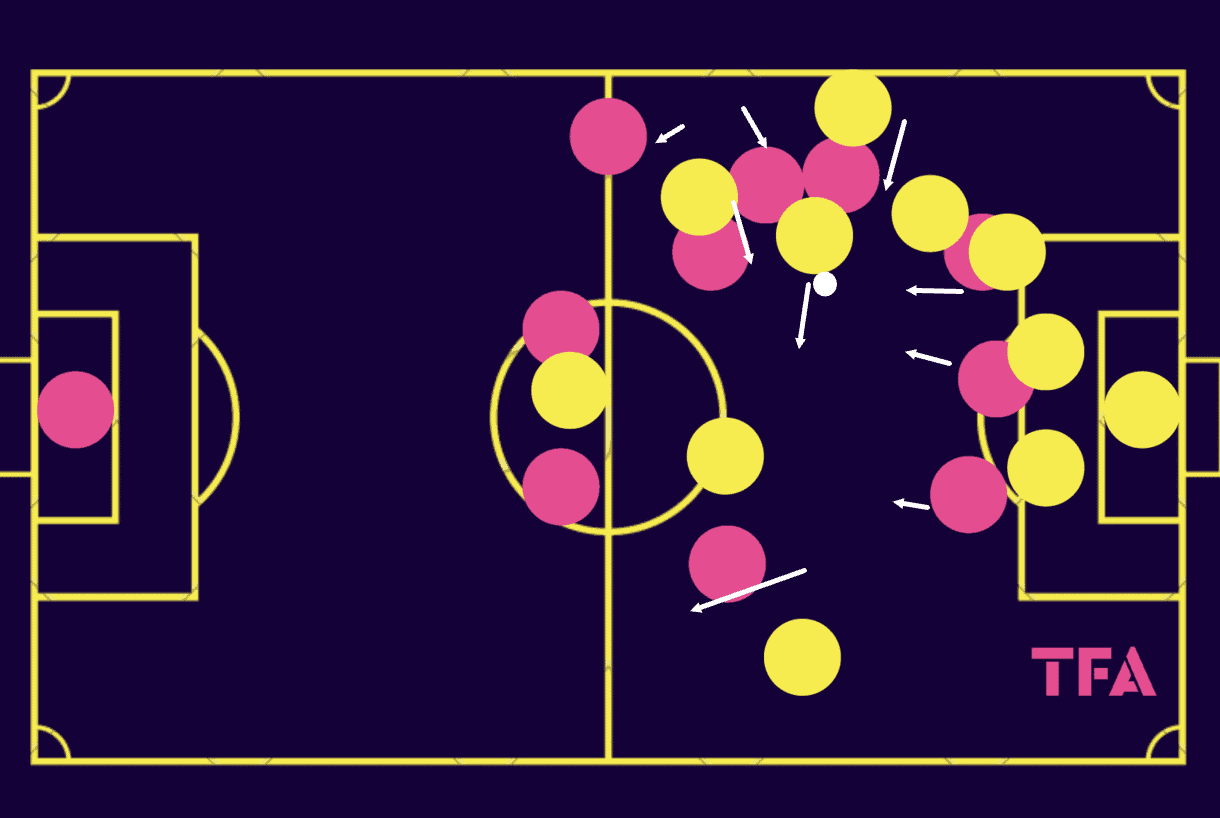
Immediately, Le Havre bodies sprung into action, particularly those of the midfielders nearby. At the same time, the full-backs began sprinting back to the backline, including the right-back, who had inverted quite a bit to provide support in possession.
Typically, this full-back inversion also serves to provide a counterpressing threat, but in this case, the player perhaps deemed the counterattack to have originated too far away, so he decided against jumping forward — a wise decision as his tracking back proved crucial to defending this counterattack.
Indeed, Le Havre’s defenders had to display excellent 1v1 defending ability last season, as they often had to deal with tricky dribblers running at them on the counter. This individual 1v1 quality was also crucial to Le Havre’s solid defensive record and the overall defensive/transition to defence structures.
Elsner will be hoping to see his side utilise this weapon they honed last season to significant effect in the top flight this season and at least keep the team clear of the drop.
Carles Martínez, 39 years old, Toulouse
Last up is new Toulouse boss Carles Martínez, who was at the club as an assistant coach last season but enters the 2023/24 campaign with the head coach position of a senior team for the very first time.
This also makes Martínez a bit of an unknown and difficult to predict. However, we know some about his coaching background and philosophical views, which can provide valuable insight into how he’ll ideally see his team play.
As per Les Violets, after being appointed as Toulouse boss, Martínez was asked about his vision of football, to which he responded:
“There are two ways to control a match: with the ball and defensively, pushing opponents to places you want them to play. I like my team to have the ball but not to make it sterile; I want us to create things… All coaches want to dominate games, to have the ball. Some accept to suffer to counter because they are good at counterattacking. me, it’s different. If I see my players suffer on the pitch, I suffer too. We have all the right tools to succeed. I want us to dominate every metre of the pitch.”
In this regard, the coach has made it very clear what he wants to see from his team, and this isn’t a big difference from what we saw from the 2022/23 Coupe de France winners last season, as Toulouse ended the Ligue 1 campaign with the eighth-highest average possession percentage (49.9%) — an impressive go at accomplishing their goal of controlling games when you consider they had only just been promoted from Ligue 2 last season.
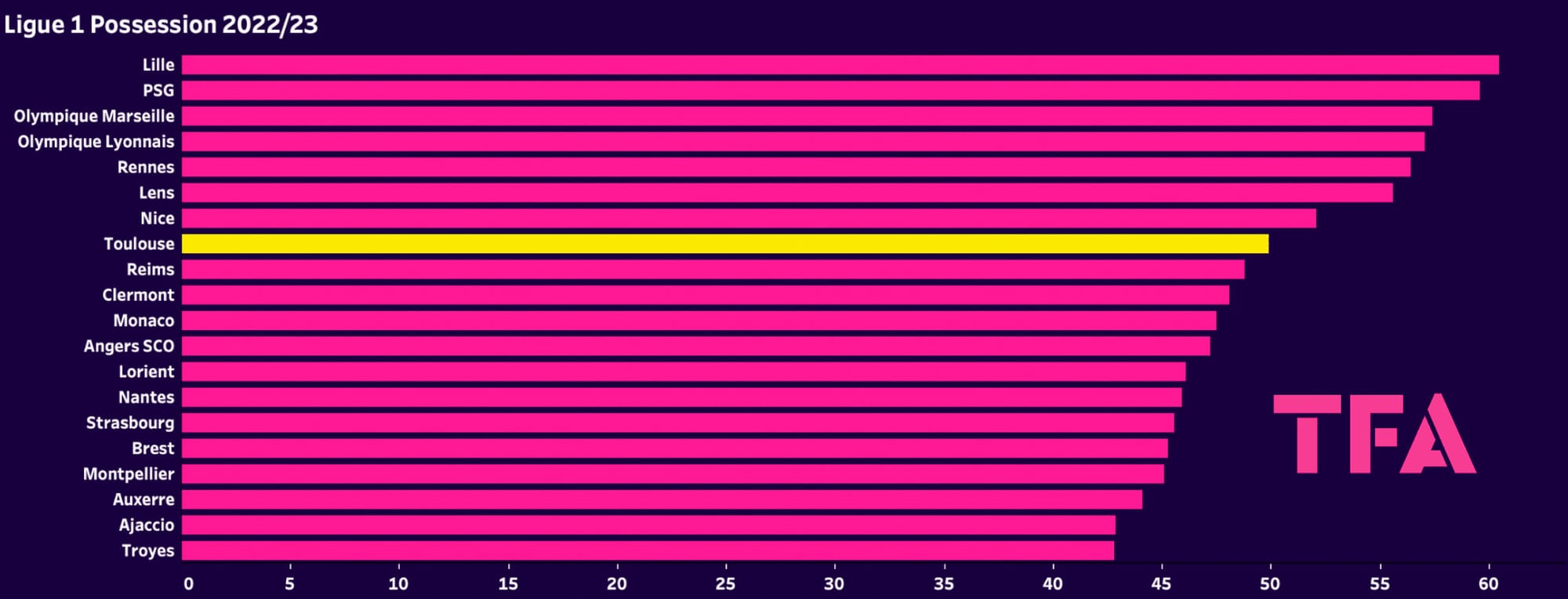
The new Téfécé boss is a young coach but has been involved in coaching for a long time, with experience at both Espanyol and Barcelona at youth level. Speaking on his appointment, Toulouse’s Director of Football Damien Comolli declared: “We talked about passion and style of play, player development and alignment in our vision” when preparing for the season ahead.
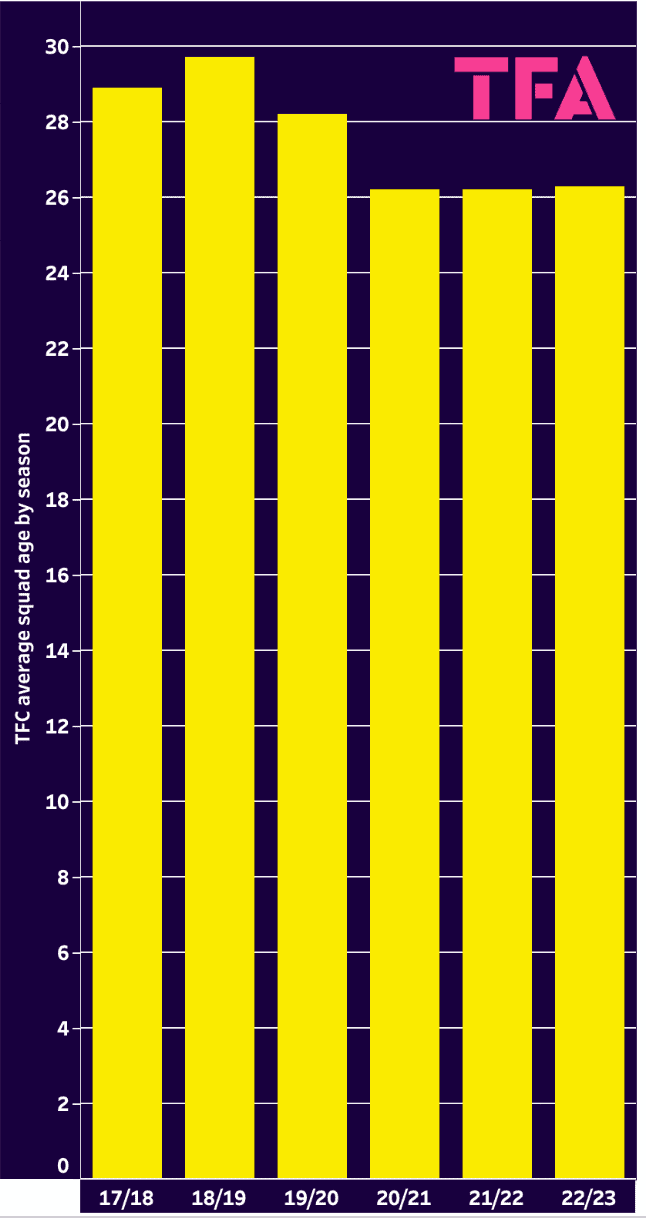
Player development, making good use of their illustrious youth academy and committing to a young squad are vital parts of Comolli’s vision for the club. He may have had to clarify with Martínez that the pair aligned. We can see from figure 12 how Toulouse’s average age has reduced since their 2019/20 relegation when the club underwent a reset.
With plenty of experience working with young players and still being a young manager himself, it’s perhaps not overly surprising that Martínez demonstrated precisely the right qualities in his role as assistant last season to earn the backing of the club to take the Coupe de France champions forward.
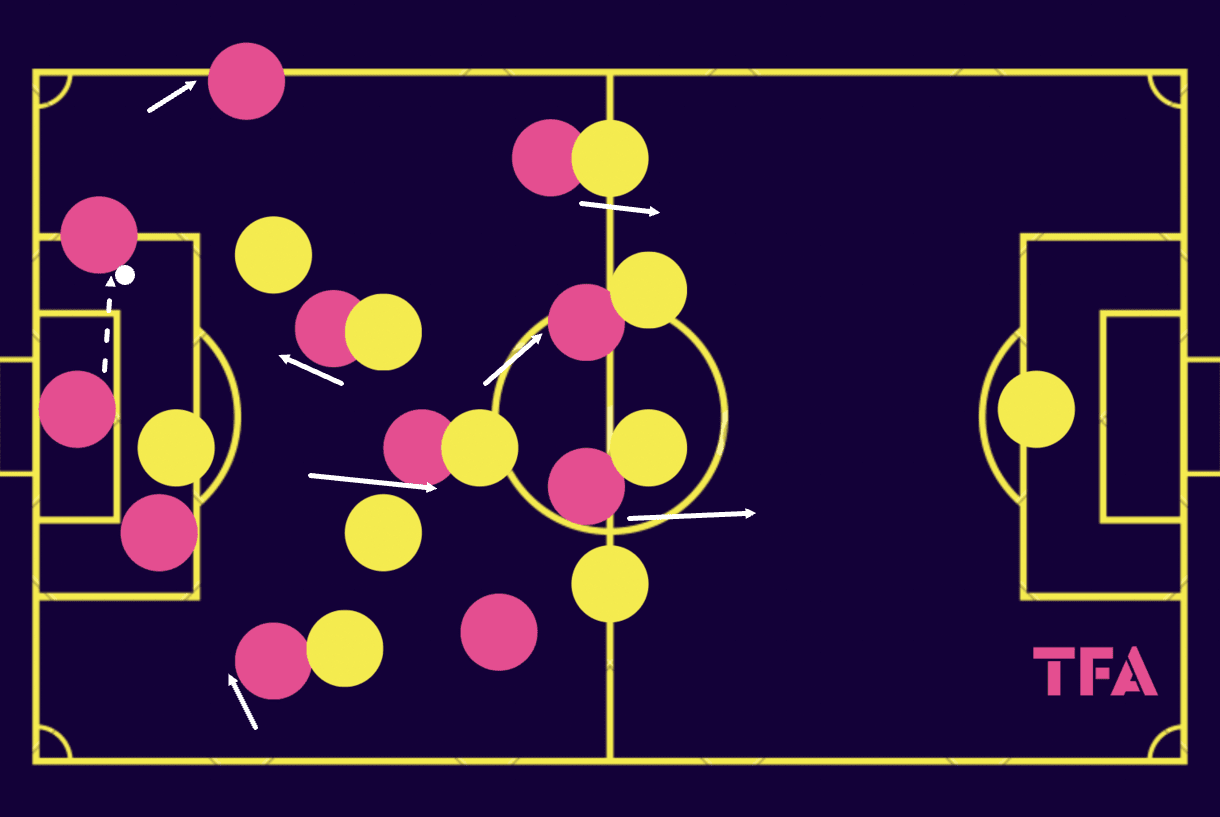
In terms of their performance on the pitch, it would seem that Martínez’s most absorbing area will be in possession, though again, it’s his first senior management position, so we’ll know a lot more about him in even just a few months!
Something Toulouse made great use of last season was a deep build-up with the goalkeeper playing the ball out to the centre-backs on either side of him, with the ball-near full-back then also dropping deep and wide to offer a decent passing option to suit the team’s strategy of dragging the opposition’s press high upfield.
The goal of this is to create space behind the opposition’s defensive line for the dynamic attack of Thijs Dallinga (who scored 18 in all competitions last season), Zakaria Aboukhlal (who scored 15 in all competitions last season) and Farès Chaïbi (who scored eight in all competitions last season) to get in behind and generate good goalscoring opportunities.
These forwards are particularly dangerous in 1v1s, or when played into space, they can attack with their pace, which makes this strategy of Toulouse’s quite effective, as if the opposition don’t push up and focus on protecting the space in behind, Toulouse could find the dangerous attackers in between the lines before generating an opportunity to run at a defender 1v1. In contrast, if they do press, this creates space behind — equally dangerous, as stated.
Last season, Les Violets did an excellent job of creating opportunities for these attackers. The midfield and backline supplied them with excellent balls, but there has been a large player turnover at the club — the nature of the ‘League of Talents’ — and one of Martínez’s significant challenges will be to find the right balance with the new squad to maintain the quality of chance creation they had last season to keep the hungry young attackers sufficiently fed.
If he can achieve this with the likes of new midfield creator Cristian Cásseres Jr. (signed from New York Red Bulls), then Toulouse should continue their upward trajectory.
Conclusion
To conclude this tactical analysis, we hope we’ve given you some reasons to check out these teams and coaches in 2023/24. If not, remember that the vast majority of this league has a fascinating coach in charge this season, and it could be just as much fun to keep an eye on throughout the campaign!





Comments